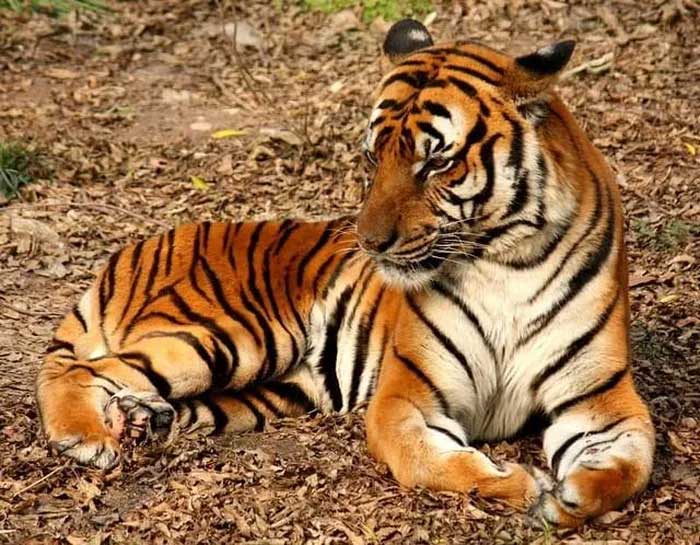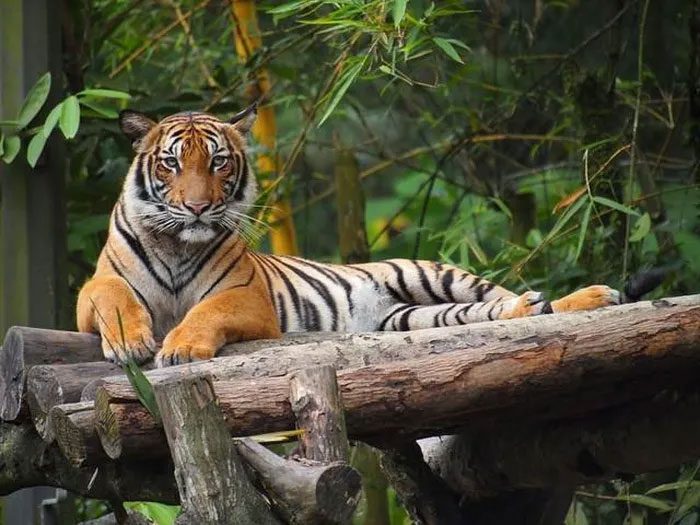The tiger – the lord of the jungle, symbolizes strength. The number of tigers in the wild has been continuously declining over the past decades. Currently, the wild tiger population is estimated to be less than 4,000.
The Rarest Tiger Species in the World
Tigers are a flagship species in zoos around the world and have fascinated humans for centuries. However, despite their popularity, tigers are one of the most critically endangered species globally.
The following six rare tiger species are at risk of extinction, with some classified as critically endangered.
One of the tiger species on this red list is even considered extinct in the wild, with only a few individuals remaining in captivity.
While many factors contribute to the decline of wild tiger populations, the greatest threat they face comes from human activities, including illegal hunting, habitat loss, and poaching.
It is hoped that raising awareness about the current plight of tigers can help in the conservation of this powerful symbol of strength.
1. South China Tiger
- Current estimated population: Essentially extinct in the wild, but about 100 individuals exist in captivity.
- Habitat: Southeast China – primarily in Hainan’s tropical forests.
- Current conservation status: Critically endangered.
- Scientific name: Panthera tigris amoyensis.

The South China Tiger is classified as one of the rarest in the world because it is essentially extinct in the wild. (Image source: Wikimedia Commons)
The South China Tiger has been declared “essentially extinct” in the wild by scientists, making it the rarest tiger species in the world. While the South China Tiger has not been sighted in the wild for over 25 years, there are about 100 tigers in captivity, and breeding programs are ongoing.
Previously, it was believed that the captive population of the South China Tiger was too small and lacked genetic diversity, but since the publication of focused breeding guidelines a few years ago, there is some hope that the South China Tiger may be reintroduced to the wild in the future.
In the early 1950s, it was estimated that there were about 4,000 wild South China Tigers, but those numbers have significantly decreased over the decades. Thousands of South China Tigers were killed as “pests,” and many more died due to habitat degradation.
The skull of the South China Tiger is different from all other surviving tiger species. Therefore, the South China Tiger is considered a primitive tiger species from which all current tiger species evolved.
2. Malayan Tiger
- Current estimated population: 250 – 340.
- Habitat: Southern and central regions of the Malay Peninsula; southern tip of Thailand.
- Current conservation status: Critically endangered.
- Scientific name: Panthera tigris jacksoni.

Malayan Tiger. (Image source: Wikimedia Commons).
Before 2004, the Malayan Tiger was classified as a subspecies of the Indochinese Tiger. However, after genetic analysis, it was determined that the Malayan Tiger is its own subspecies and was named Panthera tigris jacksoni, in honor of the famous tiger conservationist Peter Jackson (not the renowned film director).
As its name suggests, the Malayan Tiger is primarily found in the southern and central regions of the Malay Peninsula. There are also a small number of Malayan Tigers in the southern tip of Thailand. The greatest threat to the Malayan Tiger population comes from deforestation for logging and road construction, which leads to habitat loss.
In the Malay language, the Malayan Tiger is called “harimau,” often shortened to “rimau.”
3. Indochinese Tiger
- Current estimated population: approximately 350 individuals
- Habitat: Myanmar; Thailand; Laos; Vietnam; Cambodia; southwestern China (possibly extinct in this region).
- Current conservation status: Endangered.
- Scientific name: Panthera tigris corbetti.
The Indochinese Tiger originates from Myanmar, Thailand, Laos, Vietnam, Cambodia, and southwestern China. However, scientists believe that the Indochinese Tiger may be extinct in China, as no individuals have been sighted in this region in recent years.
Research also indicates that there may be no purebred Indochinese Tigers left in Cambodia and Vietnam.

The Indochinese Tiger currently has about 350 individuals remaining. (Image source: Wikimedia Commons).
While all tiger species are quite elusive, the Indochinese Tiger is particularly solitary and difficult to track, making it less understood in terms of its behavior in the wild. Of all remaining tiger subspecies, the Indochinese Tiger is the least represented in captive populations. Since the Malayan Tiger was separated as a distinct subspecies in 2004, the number of Indochinese Tigers in zoos worldwide is believed to be lower than before.
The scientific name of the Indochinese Tiger, Panthera tigris corbetti, pays tribute to Jim Corbett, a British hunter who hunted man-eating tigers and leopards in India, but later became a conservationist.
4. Sumatran Tiger
- Current estimated population: 400 – 600.
- Habitat: Sumatra, Indonesia (Sunda Islands).
- Current conservation status: Critically endangered.
- Scientific name: Panthera tigris sumatrae or Panthera tigris sondaica.

The Sumatran Tiger is classified as critically endangered. (Image source: Wikimedia Commons).
The Sumatran Tiger is the last remaining tiger subspecies in the Sunda Islands of Indonesia, which were once home to the Bali and Javan Tigers – the Bali Tiger became extinct in the 1950s, while the Javan Tiger was last seen in the 1980s.
Information sources vary, but it is estimated that there are approximately 400 to 600 Sumatran Tigers left in the wild.
DNA analysis shows that the Sumatran Tiger became isolated from other tiger populations after rising sea levels occurred between 12,000 and 6,000 years ago. Consequently, the Sumatran Tiger evolved distinctly and has no issues living on its native island.
The Sumatran Tiger population is declining primarily due to human activities such as the expansion of palm oil plantations.
The Sumatran Tiger is the smallest tiger subspecies and also has the darkest coat (dark orange) and the highest stripe density compared to other tiger species.
5. Siberian Tiger
- Current estimated population: 500 – 600.
- Habitat: Russian Far East; northeastern China; and possibly North Korea.
- Current conservation status: Endangered.
- Scientific name: Panthera tigris altaica.
The Siberian Tiger, or Amur Tiger, is primarily found in the dense forests of the Russian Far East, but also inhabits northeastern China and possibly North Korea. Historically, the range of the Siberian Tiger was much larger and could be found throughout the Korean Peninsula, northern China, Mongolia, and additionally, the Russian Far East.

The Siberian Tiger lives in cold regions such as the Russian Far East and northern China. (Image source: Wikimedia Commons).
Unfortunately, excessive hunting has nearly decimated the wild Siberian Tiger population, and its numbers have fluctuated over the years. After Russia became the first country to grant full protection to the Siberian Tiger subspecies, the population of this tiger stabilized at over 500 individuals but remains below 600.
In captivity, the Siberian Tiger is the largest of the remaining tiger subspecies, weighing up to 300 kg and measuring 3.28 meters in length. However, in the wild, Siberian Tigers tend to be larger.
6. Bengal Tiger
- Current estimated population: 2,603 – 3,346 individuals.
- Habitat: Indian subcontinent (Bangladesh, Nepal, and Bhutan).
- Current conservation status: Endangered.
- Scientific name: Panthera tigris tigris.

The Bengal Tiger inhabits South Asia. (Image source: Wikimedia Commons).
As the most populous tiger subspecies, the Bengal Tiger is found in zoos and wildlife parks worldwide, and even in live performances in Las Vegas.
Despite the existence of more than five rare tiger species combined, the Bengal tiger remains an endangered species classified as critically endangered. Like all other tiger species, the Bengal tiger population is declining, primarily facing threats from humans, especially illegal poaching.
The reason for the relatively higher population of Bengal tigers (compared to other tiger subspecies) is that many have been kept in captivity since 1880 and have been widely bred with other tiger subspecies.
Above are six tiger species listed on the Red List that need global conservation. We hope that on the occasion of the Lunar New Year in 2022, readers can choose their favorite tiger species.





















































